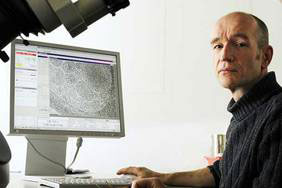| Nov 19, 2010 | |
Early phase of atherosclerosis imaged at the nanoscale |
|
| (Nanowerk News) Atherosclerosis is characterized by hardening and thickening of artery walls, with serious health consequences. Researchers at TU/e have imaged the stages in the calcification at a nanometer scale. The growth of hardening follows almost the same process as bone or tooth formation. The results will be published in Nature Materials ("The role of prenucleation clusters in surface-induced calcium phosphate crystallization"). | |
 Nico Sommerdijk The images made by researcher Nico Sommerdijk (Laboratory of Materials and Interface Chemistry, Department of Chemical Engineering and Chemistry) and his team resolve a long-standing dispute. As long ago as 1965, Aaron S. Posner suggested in the journal Nature how the calcification - the formation of calcium phosphate – in a biological environment takes place, although this met with considerable resistance at the time, Sommerdijk explains. However, his observations now confirm Posner's 45-year-old idea. Calcium and phosphate ions dissolved in the blood are not deposited directly as crystalline material on the artery wall, but first pass through an intermediate phase. In this phase they first form prenucleation clusters, followed by amorphous nanoparticles measuring approximately 50 nanometers (1 nanometer is a millionth of a millimeter). Only then does crystallization occur, causing hardening of the artery wall. The researchers hope that this understanding will be used to develop new forms of treatment for atherosclerosis. Serum |
|
| Because atherosclerosis cannot be observed at a nanometer scale in living persons, the researchers used imitation serum – a fluid containing exactly the same substances as those found in the blood itself, except for the organic materials. The researchers placed this serum in contact with a membrane with the same characteristics as the artery wall, on which the process of calcification then began. They imaged the various steps of this process using a special electron microscope, the cryoTitan. This microscope allows researchers to observe very rapidly frozen samples at the level of individual atoms, so that a process can be arrested and viewed step-by-step. | |
| All living beings | |
| Sommerdijk has already showed that the process of shell growth and bone formation takes place in the same way as atherosclerosis. "It seems that all mineralization systems in living beings take place in the same way. And there are increasing indications that it works similarly everywhere", says Sommerdijk. | |
| Three articles in Nature Materials | |
| The publication will appear in the December edition of the leading scientific journal Nature Materials, which also contains another article by Nico Sommerdijk. This deals with understanding the mechanisms of bone growth; a related research project. According to the editors of Nature Materials it is rare for two publications by the same researcher to appear in the same edition of the journal. "It happens maybe once a year", says Alison Stoddart of Nature Materials. "Only five to ten per cent of the articles submitted are actually selected for publication. So if two are published at the same time it's quite a rare event." As well as the articles themselves, the journal is also publishing a two-page editorial in which an external specialist presents his own view of Sommerdijk's research findings. |
| Source: Eindhoven University of Technology |
